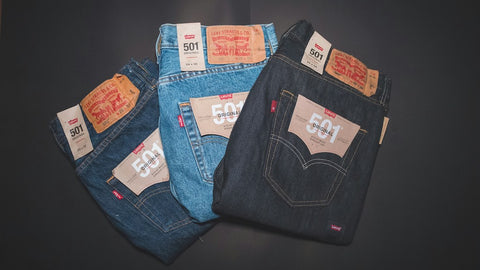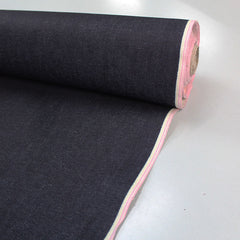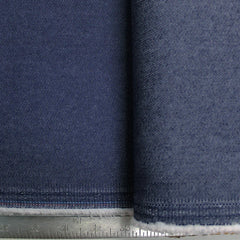Did you know that Harvey Nicholls sells an impressive 700 pairs of jeans a week, while Selfridges tops that with over 1,000? It's clear that our love for denim is strong. But have you ever wondered how these iconic trousers came to be? Buckle up because we're taking a trip down the fascinating history of jeans!
From Nimes to Rivets: The Early Days
Our story of jeans starts in the 1870s, with a fabric called denim. This sturdy twill weave gets its name from the French town of Nimes, where it was first produced. Interestingly, there are two theories about the name "denim": some say it's simply the anglicised version of "Nimes," while others believe it was a marketing tactic at the time to add a touch of European flair.
Enter Levi Strauss, a fabric wholesaler, and Jacob Davis, a tailor. Together, they saw the potential of denim for workwear and in 1873, they patented a revolutionary design: indigo-dyed denim trousers with copper rivets at stress points like pockets. This innovation proved to be a game-changer, making jeans incredibly durable workwear for miners, cowboys, and labourers.
From Cowboys to Rebels: The Rise of Fashion Jeans
While jeans were initially associated with manual labour, the 1920s and 30s saw a shift. Hollywood Westerns started romanticising the cowboy figure, often portrayed by iconic actors like John Wayne and Gary Cooper, clad in denim. This exposure helped jeans transition from purely practical attire to something associated with rugged masculinity and adventure.
By the 1940s, women were also embracing denim. Actresses like Ginger Rogers and Carole Lombard were seen sporting jeans casually, inspiring everyday women to do the same. Levi's, ever the trendsetters, launched their first women's jeans, the "Lady Levi's," in 1934.
The 1950s witnessed a pivotal moment in denim history. Jeans became a symbol of rebellion, especially among teenagers. Groups like the Hell's Angels, founded in 1948 by World War II veterans in California, embraced jeans as part of their motorcycle-riding attire. This association with rebellion led to jeans being banned in some American schools, ironically only fuelling their status as a symbol of youthful defiance and making them even cooler.
Marlon Brando's iconic portrayal of a motorcycle-riding rebel in "The Wild One" (1953), complete with his 501s and leather jacket, solidified this association. James Dean followed suit in "Rebel Without Cause" (1955), further cementing the "bad boy" image associated with jeans.
A Flourishing Industry

The denim industry continued to flourish throughout the decades. In 1886, Levi Strauss introduced their now iconic "Two Horse" trademark, showcasing the strength of their jeans. 1890 saw the birth of the legendary blue denim 501 jeans, which quickly overshadowed the initial offering of duck brown denim.
This decade also witnessed the launch of other notable denim brands: OshKosh B'Gosh in 1895, Blue Bell (later known as Wrangler) in 1904, and Lee Mercantile in 1911. Interestingly, 1908 saw the establishment of the Morris Cooper Factory in England, specialising in blue denim clothing, which would eventually evolve into the Lee Cooper brand we know today.
Notably, 1922 marked another milestone for Levi's with the introduction of belt loops to their jeans. Adding to this thriving industry, 1954 saw a shift in convenience with the introduction of zippers replacing button flies on Levi's jeans.
From Rock n' Roll to Designer Dreams: The Evolution Continues
Jeans continued to evolve throughout the decades. In the 1950s, the British brand, Lee Cooper, started connecting jeans with music, collaborating with artists like The Rolling Stones and Rod Stewart.
The 1970s saw the birth of "designer denim" with Calvin Klein's iconic campaign featuring Brooke Shields. This marked the entrance of high fashion into the denim world.
A Look to the Future of Jeans
While we revel in the rich history and undeniable popularity of jeans, it's important to acknowledge their environmental impact. The production of conventional denim has a significant carbon footprint, roughly 4-5 times that of a t-shirt. As responsible consumers, we can be mindful of our choices and explore sustainable denim options made from recycled materials or organic cotton.
So, the next time you slip into your favourite pair of jeans, remember the journey they've taken – from humble beginnings as workwear to a symbol of rebellion and ultimately, a fashion staple. And let's all strive towards a future where our love for denim doesn't come at the cost of the environment.
Making your own: the Best Jeans Patterns
If our trip down the history of jeans has inspired you to make your own, here are some of the top-selling jeans patterns in the UK, many of which feature in our friends at The Foldline’s blog, Top 10 Indie Jeans Sewing Patterns.
- Closet Core Ginger Jeans: A popular pick, the Ginger Jeans by Closet Core is a versatile pattern available in mid-rise cut with skinny and stovepipe leg options. It features subtle back pocket shaping and a higher back rise for a flattering fit. This pattern is highly praised for its custom fit and detailed instructions. It is suitable for a stretch denim with minimum 2% lycra.


Closet Core Ginger Jeans and Stretch Denim Fabric in Neutral Ecru
2. Anna Allen Helene Jeans: Known for its versatility and excellent pattern drafting, the Anna Allen Helene Selvedge Jeans is based on heritage denim jeans from the 1930s-1960s. It includes classic details like coin pockets and belt loops, making it a top choice for those seeking a vintage-inspired look. They recommend a selvedge denim, non-stretch denim, cotton drill or even twill.


3. Cashmerette Ames Jeans: Ideal for apple or pear shapes, the Cashmerette Ames Jeans pattern offers tailored fits with high rise, a pocket stay for shaping, and options for skinny or straight legs. This pattern is designed to provide a flattering silhouette for different body shapes. A 9.5-12 oz stretch denim with minimum 2% lycra is recommended.


4. I AM Patterns Sunshine Jeans: A modern take on classic jeans, the I AM Patterns Sunshine Jeans offer a choice between tapered or slouchy legs. With details like Italian pockets, rivets, and contrast topstitching, these jeans are perfect for creating stylish off-duty looks. This pattern recommends non stretch woven fabrics like denim, twill, corduroy or cotton velvet.


5. Itch to Stitch Eddystone Jeans: Featuring a classic five-pocket design with a pocket stay, the Itch to Stitch Eddystone Jeans come in two styles and offer a straight leg fit that sits at the belly button. This pattern is known for its attention to detail and classic denim look. Firm stretch fabric like twill, denim and corduroy are great choices for this all bases covered pattern.


The Best Jeans Patterns need Great Denim Fabric
These top jeans patterns cater to various styles and body shapes, providing options for both classic and modern denim looks for our sewing community. If you would like to learn more about denim fabric, head over to our denim blog to learn all about selvedge denim, indigo denim and stonewashed denim. We hope we have inspired you to create your own pair and become part of the never ending history of jeans.


